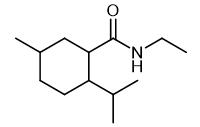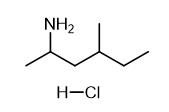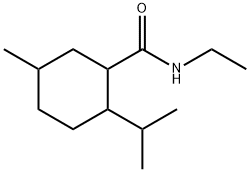Synthesis and Application of N-Ethyl-p-menthane-3-carboxamide
Oct 9,2022
Generally speaking
Cyclohexanecarboxamide (Ethyl menthane carboxamide, WS3, Hexahydrobenzamide) is a refrigerant and a TRPM8 receptor agonist with EC50 of 3.7 μM.

Fig. 1 The structure of N-Ethyl-p-menthane-3-carboxamide.
Synthetic routes

Fig. 2 The synthetic method 1 of N-Ethyl-p-menthane-3-carboxamide.
0.89 g (0.0091 mol) of polyphosphoric acid (85%) and 0.42 g (0.0091 mol) of ethanol were weighed. 0.54 g (0.0046 mol) of diethylcarbonate was added dropwise slowly while cooling in an ice bath, wherein the temperature increases slightly. After about 5 minutes, 0.5 g (0.0030 mol) of p-menthane-3-carbonitrile was added. The reaction solution was heated and stirred for 102 hours at 150°C. At the end of the reaction by GC, about 70% of desired N-Ethyl-p-menthanecarboxamide was formed [1].

Fig. 3 The synthetic method 2 of N-Ethyl-p-menthane-3-carboxamide.
0.89 g (9.1 mmol) of 85% Polyphosphoric acid and 0.62 g (13.5 mmol) of ethanol were weighed and 0.7 g (4.5 mmol) of phosphorus oxychloride was added dropwise under cooling. The solution was subsequently mixed with 0.5 g (3.0 mmol) of p-menthone-3-carbonitrile. The reaction solution was boiled for 8 hours at 140°C. The GC analysis shows a conversion of 92.5%. The desired product, the menthamide was identified by the mass spectrum [1].

Fig. 4 The synthetic method 3 of N-Ethyl-p-menthane-3-carboxamide.
0.89 g (9.1 mmol) of 85% polyphosphoric acid and 0.42 g (9.1 mmol) of ethanol were weighed, and 0.61 g (4.5 mmol) of sulfuryl chloride was added dropwise under cooling. The solution was subsequently mixed with 0.5 g (3.0 mmol) of p-menthone-3-carbonitrile. The reaction solution was boiled for 2 hours at 150°C. The GC analysis showed a conversion of 94.5%. The desired product, the menthamide, was identified by its mass spectrum [1].
Application
Flavourant levels and synthetic coolant
Background 'Juul' is the dominant US e-cigarette brand and was recently introduced to Canada, UK, France, Germany and Italy, with several flavours available across countries. US/Canadian products are sold with 5%, 3% and 1.5% (Canada only) nicotine content, whereas European Union (EU) regulation limits nicotine content to 1.7%. The differential nicotine content raises the question if flavour profiles and Juul device power output differ between countries. Methods 'Mint', 'Vanilla' and 'Mango' e-liquids from all six countries were purchased in 2019 and analysed by GC/MS for their principal flavourant and nicotine content. In addition, device power specifications were compared for devices purchased from the respective countries. Results Compositions of Juul e-liquids from the USA and Canada were identical and differed from the EU-marketed liquids, in which principal flavourant concentrations were significantly lower. EU Juul 'Mint' e-liquids contained a synthetic coolant, N-ethyl-p-menthane-3-carboxamide (WS-3), absent in US/Canadian products. US/Canadian 'Mango' e-liquid contained triethyl-citrate, an emulsifier. Nicotine contents matched label information, and devices had identical power specifications. Conclusions Tested US/Canadian Juul e-liquids contained higher flavour concentrations than EU products, likely reflecting adaptation to user preferences. In EU, 'Mint' e-liquid, menthol is partially substituted with the synthetic coolant WS-3 that elicits a cooling effect like menthol but lacks its distinct 'minty' odour. The inhalational safety of WS-3 is unknown. The use of an emulsifier in US/Canadian 'Mango' Juul e-liquid may be necessary to keep the product homogeneous. Similar power specifications of devices between countries suggest that nicotine aerosol delivery is likely proportional to the e-liquid nicotine content [2].
The popularity of disposable fourth-generation electronic cigarettes (ECs) among young adults and adolescents has been increasing since the ban on flavored cartridge EC products such as JUUL. Although the constituents and toxicity of some cartridge-based fourth-generation ECs, such as JUUL, have been studied, limited data exist for other disposable ECs such as Puff. The purpose of this study was to determine flavor chemicals, synthetic coolants, and nicotine concentrations in 16 disposable Puff devices, evaluate the cytotoxicity of the different flavors from the Puff brand using in vitro assays, and investigate the health risks of synthetic coolants in EC products. Gas chromatography/mass spectrometry was used to identify and quantify chemicals in Puff EC fluids. One hundred and twenty-six flavor chemicals were identified in Puff fluids, and 16 were >1 mg/mL. WS-23 (2-isopropyl-N,2,3-trimethylbutyramide) was present in all products, and concentrations ranged from 0.8 to 45.1 mg/mL. WS-3 (N-ethyl-p-menthane-3-carboxamide) concentrations ranged from 1.5 to 16.4 mg/mL in 6/16 products. Nicotine concentrations ranged from 40.6 to 52.4 (average 44.8 mg/mL). All unvaped fluids were cytotoxic at dilutions between 0.1 and 10% in the MTT and neutral red uptake assays when tested with BEAS-2B lung epithelial cells. The cytotoxicity of Puff fluids was highly correlated with total chemical concentrations, nicotine, WS-23, both synthetic coolants, and synthetic coolants plus ethyl maltol. Lower concentrations of WS-23 than those in the fluids adversely affected cell growth and morphology. Concentrations of synthetic coolants exceeded levels used in consumer products. The margin of exposure data showed that WS-3 and WS-23 concentrations were high enough in Puff products to present a health hazard. Our study demonstrates that disposable Puff ECs have high levels of cytotoxic chemicals. The data support the regulation of flavor chemicals and synthetic coolants in ECs to limit potentially harmful health effects [3].
References
[1] Hendel W, Skranc W, Poechlauer P, et al. Method for the production of secondary carboxamides from nitriles and alcohols[P]. PCT Int. Appl., 2004031128, 2004.
[2] Erythropel H C, Anastas P T, Krishnan-Sarin S, et al. Differences in flavourant levels and synthetic coolant use between USA, EU and Canadian Juul products[J]. Tobacco control, 2021, 30(4): 453-455.
[3] Omaiye E E, Luo W, McWhirter K J, et al. Disposable puff bar electronic cigarettes: chemical composition and toxicity of e-liquids and a synthetic coolant[J]. Chemical research in toxicology, 2022, 35(8): 1344-1358.
- Related articles
- Related Qustion
N-Ethyl-p-menthane-3-carboxamide
39711-79-0You may like
N-Ethyl-p-menthane-3-carboxamide manufacturers
- TRPM8 antagonist WS-3
-

- $29.00 / 1mL
- 2025-12-13
- CAS:39711-79-0
- Min. Order:
- Purity: 98.00%
- Supply Ability: 10g
- N-Ethyl-p-menthane-3-carboxamide
-

- $10.00 / 1kg
- 2025-12-11
- CAS:39711-79-0
- Min. Order: 1kg
- Purity: 99%
- Supply Ability: 100 mt
- cooling agent
-

- $0.00 / 25kg
- 2025-07-15
- CAS:39711-79-0
- Min. Order: 100kg
- Purity: 99.5%-99.9%
- Supply Ability: 2000Tons






